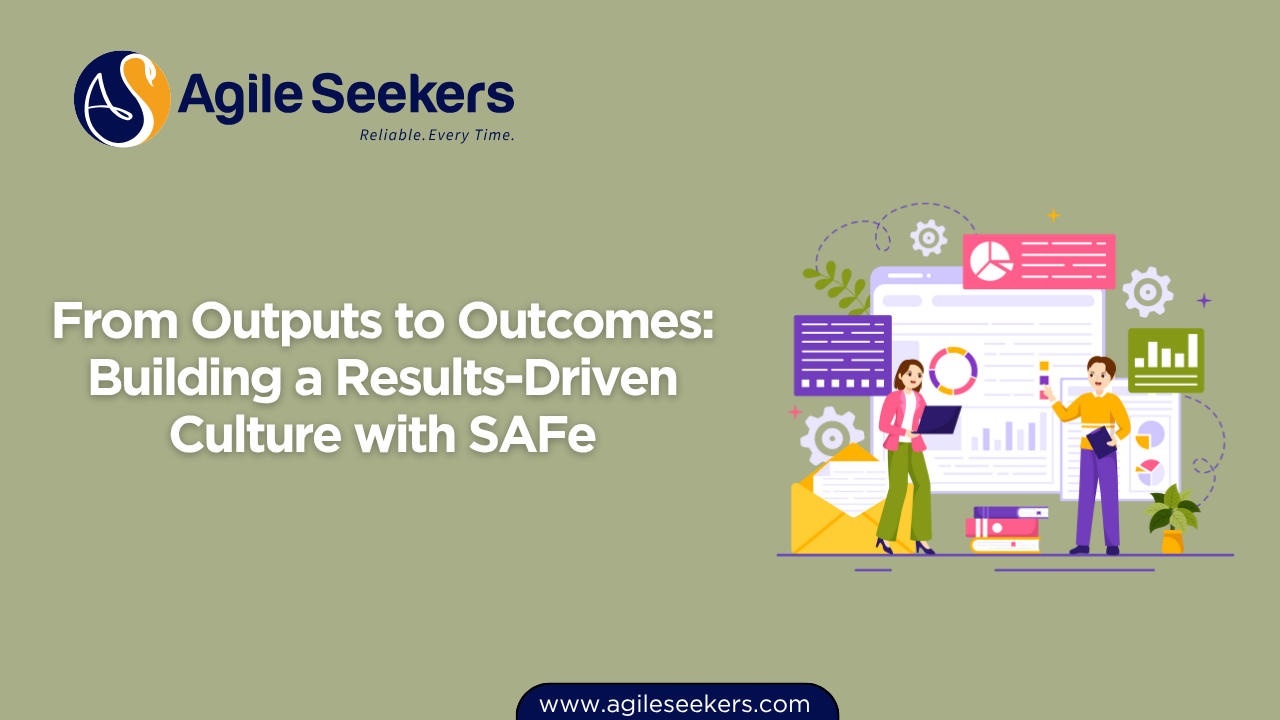From Outputs to Outcomes: Building a Results-Driven Culture with SAFe

Many organizations struggle to distinguish between "doing Agile" and "being Agile." While teams may consistently deliver features (outputs), they often fail to deliver measurable business results (outcomes). This gap between delivery and value is exactly what the Scaled Agile Framework (SAFe®) addresses through its emphasis on a results-driven culture.
Let’s explore how organizations can shift focus from outputs to outcomes using SAFe and why this shift is critical for sustainable business agility.
Understanding the Difference: Outputs vs Outcomes
Before making the shift, organizations need clarity on the distinction:
-
Outputs are the things teams produce: features, code, documentation, releases.
-
Outcomes are the actual business results achieved: customer satisfaction, increased revenue, reduced lead time, higher retention.
Delivering more features faster doesn’t always translate into customer value. In fact, focusing only on output often leads to overloaded backlogs, technical debt, and misaligned priorities.
SAFe provides a structured way to realign around outcomes by focusing on value delivery across the enterprise.
Why SAFe Promotes an Outcome-Driven Culture
SAFe encourages all roles—from Scrum Masters to Release Train Engineers—to align their work with business value. This mindset is reinforced through Lean-Agile principles and several SAFe practices:
-
Customer Centricity and Design Thinking help define what matters most to end-users.
-
PI Objectives link team activities to measurable goals.
-
Lean Portfolio Management ensures that funding and governance follow value streams, not projects.
-
Metrics such as predictability, flow, and outcome KPIs shift the focus from effort spent to impact achieved.
These practices don’t just add process—they create visibility, alignment, and accountability.
To understand and drive these changes across the organization, many professionals pursue the Leading SAFe certification, which emphasizes the Lean-Agile mindset and the role of leaders in guiding cultural transformation.
Building Blocks of a Results-Driven Culture in SAFe
1. Defining Clear Business Outcomes
To move toward outcomes, organizations must define what success looks like. SAFe encourages defining business objectives during Program Increment (PI) Planning and mapping them to quantifiable success criteria.
Tools like Objectives and Key Results (OKRs) can help frame these outcomes effectively. For example:
Output: “Deliver login feature by Sprint 4”
Outcome: “Improve user activation rate by 15% in Q2”
By encouraging each Agile Release Train (ART) to work toward outcomes, the framework helps teams move beyond task completion toward business value creation.
This alignment often begins with strong collaboration between Product Owners and Product Managers, a key focus in the SAFe Product Owner/Product Manager (POPM) certification.
2. Shaping Backlogs Around Value
A product backlog filled with features doesn't guarantee business results. SAFe recommends organizing the backlog around Epics, Capabilities, and Features that trace back to strategic themes and customer needs.
The idea is not just to build software but to prioritize the right things—what customers care about, what moves the business forward, and what supports enterprise goals.
Scrum Masters play a critical role here by guiding teams toward value-centric delivery and ensuring the backlog is not just filled with “work” but with purpose. This is a key area addressed in SAFe Scrum Master certification.
3. Making Value Visible Through PI Objectives
Each Program Increment (PI) provides an opportunity for teams to commit to specific PI Objectives—which should tie directly to desired outcomes.
Objectives should be SMART (Specific, Measurable, Achievable, Relevant, and Time-bound) and business-focused rather than technical deliverables. SAFe encourages teams to distinguish between committed objectives and uncommitted (stretch) goals, providing stakeholders with a realistic view of potential delivery.
The transparency around planned outcomes builds trust between teams and business, encouraging a shared sense of purpose.
4. Using Flow Metrics and Outcome KPIs
Shifting to an outcome-driven culture means measuring the right things.
SAFe recommends flow metrics like:
-
Flow Velocity (value delivered)
-
Flow Time (speed)
-
Flow Efficiency (waste reduction)
Alongside, Key Performance Indicators (KPIs) such as Net Promoter Score (NPS), employee engagement, and time to market, help assess impact over output.
The role of SAFe Advanced Scrum Masters becomes essential here as they coach teams to improve flow and performance using systems thinking and metrics.
For a deeper dive into flow metrics, Scaled Agile’s Flow Framework offers valuable insights.
5. Empowering Teams Through Decentralized Decision-Making
A results-driven culture needs autonomy. SAFe empowers teams to make decisions within guardrails, reducing delays caused by hierarchical approvals.
Teams that understand why they’re building something are more likely to make decisions that deliver real value. This autonomy must be backed by trust and a clear understanding of the outcomes they’re driving toward.
Training RTEs through SAFe Release Train Engineer certification helps ensure that facilitation, leadership, and coordination efforts remain aligned with value delivery across trains.
6. Reinforcing a Culture of Learning and Adjustment
Delivering outcomes is not a one-time effort—it’s a continuous learning cycle.
SAFe emphasizes Inspect & Adapt (I&A) workshops at the end of each PI to evaluate what worked, what didn’t, and how to improve. The focus here is not only on process improvement but also on how well outcomes were met and what needs to change.
This commitment to relentless improvement fosters a culture where experimentation is encouraged and failure becomes a source of insight—not blame.
Final Thoughts: The Mindset Shift That Matters
Moving from outputs to outcomes requires more than a change in tooling or processes—it’s a shift in mindset.
It’s about:
-
Thinking in terms of value rather than volume
-
Empowering teams with purpose, not just tasks
-
Holding leadership accountable for creating the conditions for value delivery
Adopting SAFe without embracing this outcome mindset may result in faster delivery of the wrong things. But when organizations align around outcomes, they unlock agility that delivers real business value.
If you’re starting this journey, investing in role-based training like Leading SAFe, SAFe POPM, or SAFe Scrum Master is one of the smartest ways to equip your team for success.
Also read - How to Define Business Outcomes for Your SAFe Transformation
Also see - Why Outcome-Based Metrics Are Critical in SAFe Transformations




















